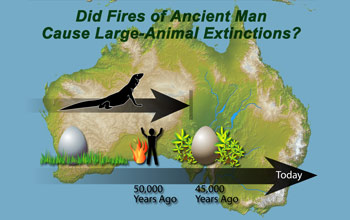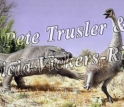News Release 05-113
When Down Under Went Up in Smoke
Fires of ancient Australians are linked to habitat change, mass animal extinctions

A 140,000-year dietary record of flightless birds implicates diet change and fire in extinctions.
July 7, 2005
This material is available primarily for archival purposes. Telephone numbers or other contact information may be out of date; please see current contact information at media contacts.
By reconstructing the diets of two flightless birds that inhabited Australia some 50,000 years ago, scientists have documented an unparalleled ecosystem change in the continent's interior and furnished the best evidence to date that humans caused massive animal extinctions through their extensive use of fire.
The research, published in the July 8 issue of the journal Science, was led by the University of Colorado-Boulder's Gifford Miller. The team measured the ratio of the stable isotopes of carbon in 1,500 fossilized eggshells of emus and the now-extinct, ostrich-sized Genyornis newtoni found at three widely separated sites to determine what type of plants the birds used as forage over a 140,000-year period.
The data reveal that the birds mysteriously switched from eating drought-adapted, nutritious grasses to unsavory, fire-adapted desert scrub. Consequently, animals like the emu that were more tolerant of dietary changes survived, while more-specialized feeders perished. The massive demise resulted in the extinction of 85 percent of Australia's largest mammals, reptiles and birds--creatures that included 19 types of marsupials or kangaroo-like animals, a 25-foot-long snake, a 25-foot-long lizard and a tortoise the size of a small car.
Previous studies had shown that no significant climate change coincided with the cataclysmic landscape transformation, but that it did occur shortly after a prehistoric land bridge allowed humans from Southeast Asia to colonize Australia, which has led to speculation that their extensive use of fire for hunting, land clearing and signaling forever changed the Aussie ecosystem.
Miller says neither human-introduced diseases, nor over hunting, the two most widely cited alternative explanations for such a massive human-caused extinction in Australia, would have resulted in such dramatic changes in the birds' diets.
"The sobering lesson from this study is that the tempo of environmental change can outpace a species' ability to adapt to the point of its extinction," said David Verardo, director of the National Science Foundation paleoclimate program that supported the research.
For a complete story, see the University of Colorado news release .
-NSF-
-
Giant lizards once preyed on the ostrich-like Genyornis newtoni. Both are now extinct.
Credit and Larger Version
Media Contacts
Richard (Randy) Vines, NSF, (703) 292-7963, email: rvines@nsf.gov
Jim Scott, University of Colorado, Boulder, (303) 492-3114, email: Jim.Scott@colorado.edu
Program Contacts
David J. Verardo, NSF, (703) 292-8527, email: dverardo@nsf.gov
Principal Investigators
Gifford Miller, University of Colorado, Boulder, (303) 492-6962, email: gmiller@colordado.edu
The U.S. National Science Foundation propels the nation forward by advancing fundamental research in all fields of science and engineering. NSF supports research and people by providing facilities, instruments and funding to support their ingenuity and sustain the U.S. as a global leader in research and innovation. With a fiscal year 2023 budget of $9.5 billion, NSF funds reach all 50 states through grants to nearly 2,000 colleges, universities and institutions. Each year, NSF receives more than 40,000 competitive proposals and makes about 11,000 new awards. Those awards include support for cooperative research with industry, Arctic and Antarctic research and operations, and U.S. participation in international scientific efforts.
Connect with us online
NSF website: nsf.gov
NSF News: nsf.gov/news
For News Media: nsf.gov/news/newsroom
Statistics: nsf.gov/statistics/
Awards database: nsf.gov/awardsearch/
Follow us on social
Twitter: twitter.com/NSF
Facebook: facebook.com/US.NSF
Instagram: instagram.com/nsfgov



